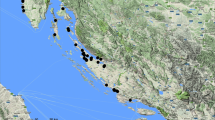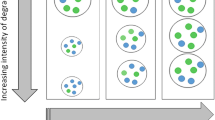Abstract
Opening summer polders as a measure to re-establish salt marshes in former grassland areas has come into discussion during the recent years. In the Leybucht (Lower Saxony) the summer dike of Hauener Hooge was partly levelled down in October 1994 as a measure of compensation for the construction project ‘Küstenschutz Leybucht’. The renaturation project includes accompanying ecological studies to check the success of the measure, carried out by the Forschungsstelle Küste and containing investigations of vegetation and arthropod fauna.
By means of carabid beetles, amphipods, and some spider groups, the development of salt marsh arthropod fauna has been studied since 1995. Arthropods were caught with pitfall traps from April to October of 1995–1997 and 1999.
First results indicate a rapid change in arthropod community due to an increased seawater influence. The abundance of the salt marsh amphipodOrchestia gammarellus increased considerably during the study period, the spider community (Lycosidae, Tetragnathidae) shifted to more hygrophilous species.
The carabid community was changing in a more differentiated way due to soil level and inundation frequency. Exclusively at the higher study sites, salt marsh species spread out, while many grassland species were still preserved until 1997. The process of species loss and declining abundances in carabids, discernible at the lower study sites already during the first years, accelerated considerably in the whole area after exceptionally numerous inundations in the summer of 1998. A carabid community of lower salt marshes with small species numbers keeps developing at most study sites, clearly dependent on soil level.
Similar content being viewed by others
References
Arens, S. (1997): Beweissicherung Küstenschutz Leybucht: Vegetationsentwicklung der Leybucht von 1948–1996. — Dienstber. Forschungsstelle Küste Norderney/Wilhelmshaven, 10/1997: 108 pp., [unpubl.].
Carr, M. R. (1996): PRIMER User Manual (Plymouth Routines in Multivariate Ecological Research). — 36 pp.; Plymouth Marine Laboratory, UK.
Freude, H. (1976): Carabidae. — In:Freude, H. &Harde, W. &Lohse, G. A. [Eds.]: Die Käfer Mitteleuropas, Bd.2: 302 pp.; Krefeld (Goecke & Evers).
Götting, E. (1995): Die terrestrische Wirbellosenfauna der Hauener Hooge (Leybucht) 1995. — Dienstber. Forschungsstelle Küste Norderney/Wilhelmshaven,23/1995: 20 pp., [unpubl.].
Götting, E. (1997): Beweissicherung Küstenschutz Leybucht: Die Carabiden — und Amphipodenfauna in den Kompensationsflächen der Hauener Hooge. — Dienstber. Forschungsstelle Küste Norderney/Wilhelmshaven,15/1997: 21 pp., [unpubl.].
Heimer, S. &Nentwig, W. (1991): Spinnen Mitteleuropas: ein Bestimmungsbuch. — 543 pp.; Berlin, (Parey).
Heydemann, B. (1960): Die biozönotische Entwicklung vom Vorland zum Koog. Teil 1: Spinnen (Araneae). — Abh. math.-naturwiss. Kl. Akad. Wiss. Lit. Mainz,11: 745–913.
Heydemann, B. (1962): Die biozönotische Entwicklung vom Vorland zum Koog. Teil 2: Käfer (Coleoptera). — Abh. math.-naturwiss. Kl. Akad. Wiss. Lit. Mainz,11: 170–370.
Irmler, U. &Heydemann, B. (1986): Die ökologische Problematik der Beweidung von Salzwiesen an der Niedersächsischen Küste — am Beispiel der Leybucht. — Naturschutz und Landschaftspflege in Niedersachsen, Heft15: 115 pp.
Lincoln, R. J. (1979): British Marine Amphipoda: Gammaridea. — 658 pp.; London (Brit. Mus. Nat. Hist.).
Lohse, G. A. &Lucht, W. H. [Eds.] (1989): Die Käfer Mitteleuropas — Ergänzungen und Berichtigungen zu Freude-Harde-Lohse „Die Käfer Mitteleuropas“, Bd.12. — 346 pp.; Krefeld (Goecke & Evers).
Meijer, J. (1974): A comparative study of the immigration of carabids (Coleoptera, Carabidae) into a new polder. —Oecologia,16: 185–208.
Meijer, J. (1980): The development of some elements of the arthropod fauna of a new polder. — Oecologia,45: 220–235.
Planungsgruppe Grün (1992): Ergänzungen zum Landschaftspflegerischen Begleitplan „Küstenschutz Leybucht“. —Gutachten im Auftrag des Wasserwirtschaftsamts Aurich: 45 pp.; Bremen.
Topp, W (1975): Zur Besiedlung einer neu entstehenden Insel. Untersuchungen am „Hohen Knechtsand“. — Zool. Jb. Systematik,102: 215–240.
Universität Bremen (1995): Salzwiesenprojekt „Wurster Küste“: Abschlußbericht zu den wissenschaftlichen Begleituntersuchungen 1992–1995. — 310 pp.; Bremen. — [unpubl. Ber. im Auftrag der Trägergemeinschaft und des BMU].
Wilkens, H. & Andres, H.-G. & Faubel, A. & Gillandt, L. & Hartwig, E. & Hüppop, O. & Martens, J. M. & Schulz, K. (1983): Ökologische Analyse der Leybucht. — Arb. Forschungsstelle Norderney,8: 144 pp.
Author information
Authors and Affiliations
Rights and permissions
About this article
Cite this article
Götting, E. Development of salt marsh arthropod fauna after opening a summer polder. Senckenbergiana maritima 31, 333–340 (2001). https://doi.org/10.1007/BF03043042
Received:
Revised:
Accepted:
Issue Date:
DOI: https://doi.org/10.1007/BF03043042




